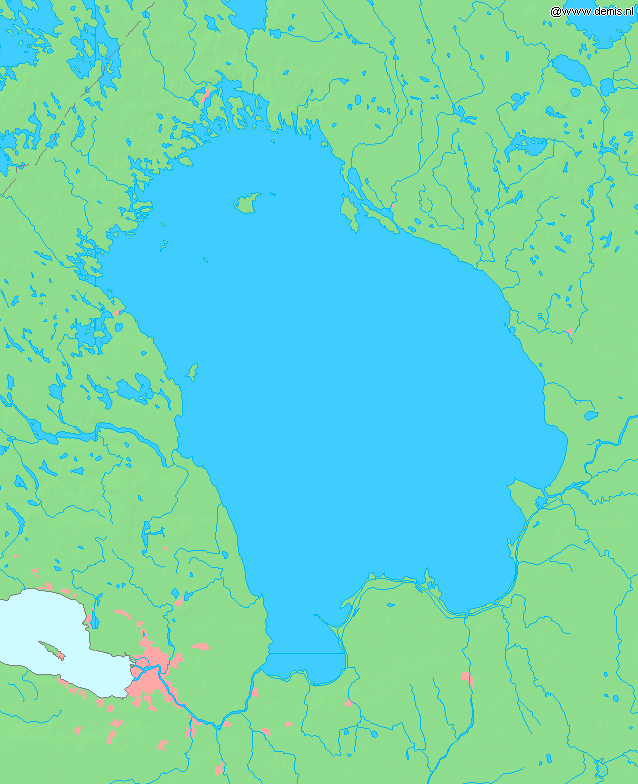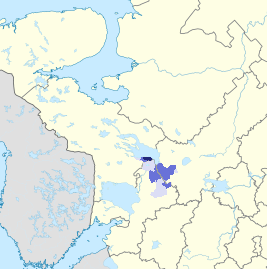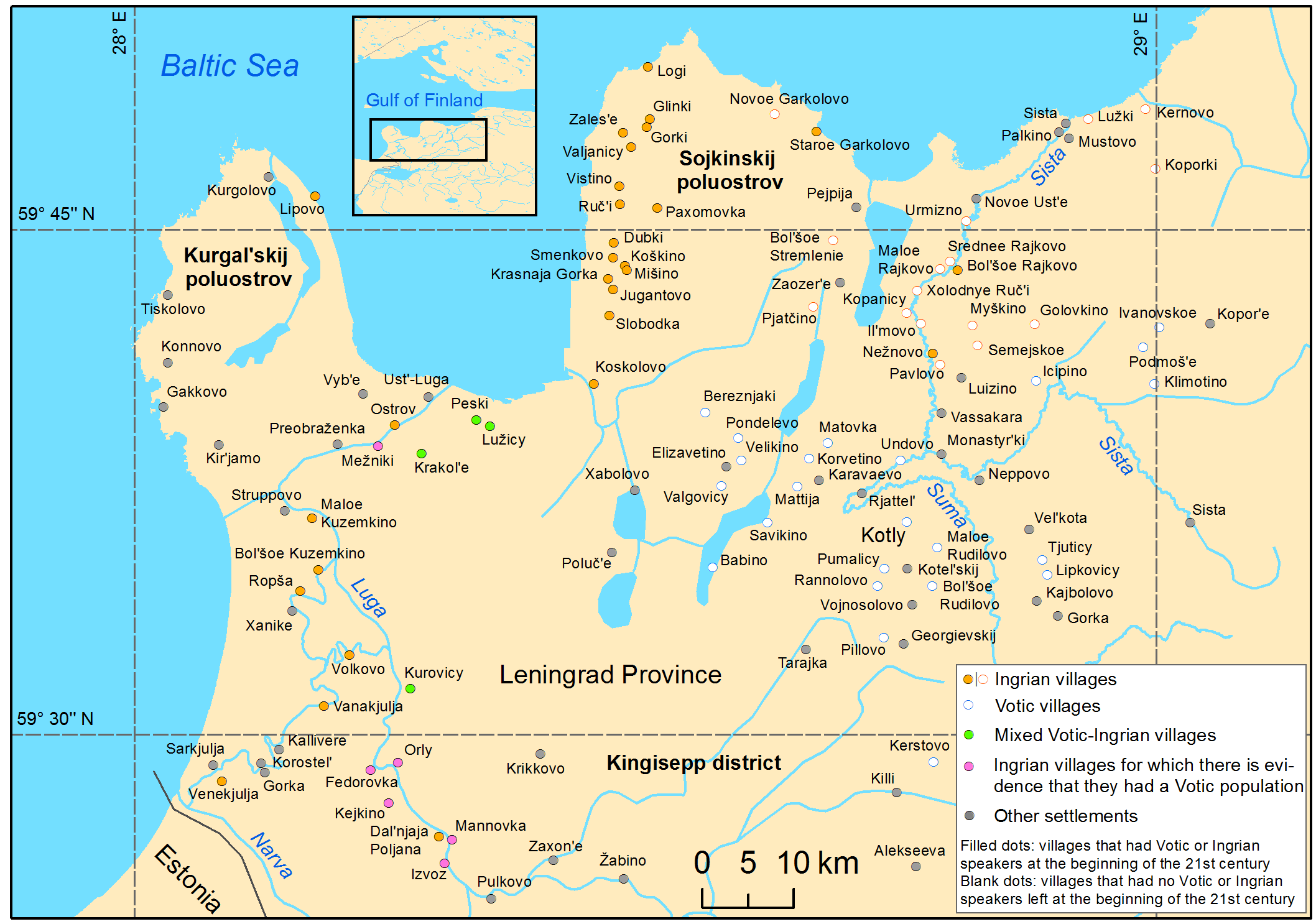|
Proto-Karelian Language
Proto-Karelian, also known as Old Karelian, was a language once spoken on the western shore of Lake Ladoga in Karelia, from which the dialects of the Karelian language (White, Southern and Livvi), Ludic, the Ingrian language, as well as the South Karelian and Savonian dialects of the Finnish language have developed. It was spoken around the 12th and 13th centuries, and the language was likely quite uniform with little regional variance. The Eastern Finnish dialects developed from Proto-Karelian when the language of the inhabitants who had moved to the area around present-day Mikkeli mixed with western, likely Tavastian, speakers of Finnish. The Livvi-Karelian dialect and Ludic developed from the mixture of the old Vepsian language spoken by the Vepsians of the Olonets Isthmus and Proto-Karelian. Innovations in Proto-Karelian include: the disappearance of *d and *g between vowels, the plural stem *-lOi-, the labialization Labialization is a secondary articulatory feat ... [...More Info...] [...Related Items...] OR: [Wikipedia] [Google] [Baidu] |
La2-demis-ladoga
LA most frequently refers to Los Angeles, the second most populous city in the United States of America. La, LA, or L.A. may also refer to: Arts and entertainment Music *La (musical note), or A, the sixth note *"L.A.", a song by Elliott Smith on ''Figure 8'' (album) * ''L.A.'' (EP), by Teddy Thompson *''L.A. (Light Album)'', a Beach Boys album * "L.A." (Neil Young song), 1973 *The La's, an English rock band *L.A. Reid, a prominent music producer * Yung L.A., a rapper *Lady A, an American country music trio * "L.A." (Amy Macdonald song), 2007 *"La", a song by Australian-Israeli singer-songwriter Old Man River *''La'', a Les Gordon album Other media * l(a, a poem by E. E. Cummings * La (Tarzan), fictional queen of the lost city of Opar (Tarzan) *'' Lá'', later known as Lá Nua, an Irish language newspaper * La7, an Italian television channel *LucasArts, an American video game developer and publisher * Liber Annuus, academic journal Business, organizations, and government a ... [...More Info...] [...Related Items...] OR: [Wikipedia] [Google] [Baidu] |
Finnish Language
Finnish (endonym: or ) is a Finnic languages, Finnic language of the Uralic languages, Uralic language family, spoken by the majority of the population in Finland and by ethnic Finns outside of Finland. Finnish is one of the two official languages of Finland, alongside Swedish language, Swedish. In Sweden, both Finnish and Meänkieli (which has significant mutual intelligibility with Finnish) are official minority languages. Kven language, Kven, which like Meänkieli is mutually intelligible with Finnish, is spoken in the Norway, Norwegian counties of Troms and Finnmark by a minority of Finnish descent. Finnish is morphological typology, typologically agglutinative language, agglutinative and uses almost exclusively Suffix, suffixal affixation. Nouns, adjectives, pronouns, Numeral (linguistics), numerals and verbs are inflection, inflected depending on their role in the Sentence (linguistics), sentence. Sentences are normally formed with subject–verb–object word order, alth ... [...More Info...] [...Related Items...] OR: [Wikipedia] [Google] [Baidu] |
Labialization
Labialization is a secondary articulatory feature of sounds in some languages. Labialized sounds involve the lips while the remainder of the oral cavity produces another sound. The term is normally restricted to consonants. When vowels involve the lips, they are called rounded. The most common labialized consonants are labialized velars. Most other labialized sounds also have simultaneous velarization, and the process may then be more precisely called labio-velarization. The "labialization" of bilabial consonants often refers to protrusion instead of a secondary articulatory feature velarization. ʷdoesn't mean ˠalthough refers to a labial–velar approximant. In phonology, labialization may also refer to a type of assimilation process. Occurrence Labialization is the most widespread secondary articulation in the world's languages. It is phonemically contrastive in Northwest Caucasian (e.g. Adyghe), Athabaskan, and Salishan language families, among others. T ... [...More Info...] [...Related Items...] OR: [Wikipedia] [Google] [Baidu] |
Olonets Isthmus
Olonets Isthmus is an isthmus between Lake Onega and Lake Ladoga in Russia Russia, or the Russian Federation, is a country spanning Eastern Europe and North Asia. It is the list of countries and dependencies by area, largest country in the world, and extends across Time in Russia, eleven time zones, sharing Borders .... Geography of the Republic of Karelia Isthmuses of Russia {{Karelia-stub ... [...More Info...] [...Related Items...] OR: [Wikipedia] [Google] [Baidu] |
Vepsians
Veps, or Vepsians (), are a Baltic Finns, Baltic Finnic people who speak the Veps language, which belongs to the Finnic languages, Finnic branch of the Uralic languages. According to the 2002 Russian census, there were 8,240 Veps in Russia. Of the 281 Veps in Ukraine, 11 spoke Vepsian according to the 2001 Ukrainian census. The self-designations of these people in various dialects are ''vepslaine'', ''bepslaane'' and (in northern dialects, southwest of Lake Onega) ''lüdinik'' and ''lüdilaine''. Almost all Vepsians are fluent in Russian language, Russian. The younger generation, in general, does not speak Vepsian; however, many have an understanding of the language. Geography In modern times, they live in the area between Lake Ladoga, Lake Onega and Lake Beloye (Vologda Oblast), Lake Beloye – in the Russian Republic of Karelia in the former Veps National Volost, in Leningrad Oblast along the Oyat River in the Podporozhsky District, Podporozhsky and Lodeynopolsky Districts ... [...More Info...] [...Related Items...] OR: [Wikipedia] [Google] [Baidu] |
Veps Language
Veps, also known as Vepsian (, or ), is an endangered Finnic languages, Finnic language from the Uralic languages, Uralic language family, that is spoken by Vepsians. The language is written in the Latin script, and is closely related to Finnish language, Finnish and Karelian language, Karelian. According to Soviet Union, Soviet statistics, 12,500 people were self-designated ethnic Veps at the end of 1989. There were 5,900 self-designated ethnic Veps in 2010, and around 3,600 native speakers. According to the location of the people, the language is divided into three main dialects: Northern Veps (at Lake Onega to the south of Petrozavodsk, to the north of the river Svir River, Svir, including the former Veps National Volost), Central Veps (in the east of the Leningrad Oblast and northwest of the Vologda Oblast), and Southern Veps (in the Leningrad Oblast). The Northern dialect seems the most distinct of the three; however, it is still mutually intelligible for speakers of the oth ... [...More Info...] [...Related Items...] OR: [Wikipedia] [Google] [Baidu] |
Tavastian Dialects
Tavastian dialects (), or Häme dialects, are Western Finnish dialects spoken in Pirkanmaa, Päijät-Häme, Kanta-Häme, and in parts of Satakunta, Uusimaa and Kymenlaakso. The dialect spoken in the city of Tampere is part of the Tavastian dialects. The Tavastian dialects have influenced other Finnish dialects (especially the Southwest Finnish dialects). Dialectal features Pronunciation of D Where Standard Finnish has /d/, the Tavastian dialects have either /r/ or /l/ in its place. The ''r''-pronunciation is the more common one. The ''l''-pronunciation is encountered on two separate areas: in the eastern boundary of the dialect area as well as in a smaller area which includes Akaa and Tammela to name a few. Therefore, ''lehdet'' (leaves) can be pronounced as ''lehret'' or ''lehlet''. However, the plural of ''vesi'' (water, standard plural ''vedet'') can be pronounced as ''veset'' in the ''r''-dialects, in order to not cause confusion with ''veret'' (bloods, plural of ... [...More Info...] [...Related Items...] OR: [Wikipedia] [Google] [Baidu] |
Mikkeli
Mikkeli (; ; ; ) is a List of cities and towns in Finland, city in, and the regional capital of, South Savo, Finland, located in the Finnish Lakeland. The population is approximately , while the Mikkeli sub-region of Southern Savonia has a population of approximately . Mikkeli is the most-populous Municipalities of Finland, municipality of Finland and the 19th most-populous List of urban areas in Finland by population, urban area in the country. Mikkeli is located on the shores of Saimaa, Lake Saimaa, the largest List of lakes of Finland, lake in the country, and List of largest lakes of Europe, Europe's fourth largest. Prior to being located within South Savonia, the city was in Mikkeli Province (until 1997), before becoming part of Eastern Finland Province (1997-2009). The city covers an area of , of which is water. Mikkeli is one of the largest towns in the South Savo region, and one of the main hubs in the region's Healthcare in Finland, hospital districts, along with Savonli ... [...More Info...] [...Related Items...] OR: [Wikipedia] [Google] [Baidu] |
Savonian Dialects
The Savo dialects (also called Savonian dialects or Savo Finnish) () are forms of the Finnish language spoken in Savo and other parts of Eastern Finland. Finnish dialects are grouped broadly into Eastern and Western varieties; Savo dialects are of the Eastern variety. Savo dialects are the most widely distributed Finnish dialect group (setting aside the higher-level east/west split mentioned above). They are spoken in Savo (both North and South Savo), but also in North Karelia, parts of Päijät-Häme, Central Finland, Kainuu, Koillismaa district of Northern Ostrobothnia, the lake section between Southern and Central Ostrobothnia as far north as Evijärvi and in the municipalities of Pudasjärvi and the Southern part of Ranua in Lapland. Also the language spoken by the Forest Finns in Värmland and Norwegian Hedmark of Central Scandinavia belonged to the old Savo dialects. The geographical area the Savo dialects cover makes up one-third the area of Finland. History The Savo ... [...More Info...] [...Related Items...] OR: [Wikipedia] [Google] [Baidu] |
Lake Ladoga
Lake Ladoga is a freshwater lake located in the Republic of Karelia and Leningrad Oblast in northwestern Russia, in the vicinity of Saint Petersburg. It is the largest lake located entirely in Europe, the second largest lake in Russia after Lake Baikal, and the List of lakes by area, 14th largest freshwater lake by area in the world. It is comparable in size to Lake Ontario. ''Ladoga Lacus'', a methane lake on Saturn's moon Titan (moon), Titan, is named after the lake. Etymology In one of Nestor the Chronicler, Nestor's chronicles from the 12th century a lake called "the Great Nevo" is mentioned, a clear link to the Neva River and possibly further to Finnish language, Finnish ''nevo'' 'sea' or ''neva'' 'bog, quagmire'.:ru:Поспелов, Евгений Михайлович, Evgeny Pospelov: ''Geographical names of the world. Toponymic dictionary.'' Second edition. Astrel, Moscow 2001, pp. 106f. Ancient Norse sagas and Hanseatic treaties both mention a city made of lakes named ... [...More Info...] [...Related Items...] OR: [Wikipedia] [Google] [Baidu] |
South Karelian Dialects
South Karelian dialects, Karelian dialects or Southeast Finnish dialects () are Eastern Finnish dialects spoken in South Karelia, along with eastern parts of Kymenlaakso ( Virolahti and Miehikkälä). Prior to the Winter War, the dialects were spoken along the Karelian Isthmus and Ingria. However, the South Karelian dialect speakers from the parts of Karelia taken by the Soviet Union were evacuated into the rest of Finland where their speech was assimilated into the new environment. Use of the Ingrian dialects is declining. South Karelian dialects have been influenced by Russian. Features Standard Finnish /d/: → - * ''lehen'' * Standard Finnish: ''lehden'' 'leave's' (genitive singular of ''lehti'') Standard Finnish /ts/: → /ss/, /ht/ or /st/ * ''mehtä'', ''messä'', ''metsä'' * Standard Finnish: ''metsä'' 'forest' Inessive ending: -ssA → -s * ''maas'' * Standard Finnish: ''maassa'' 'on the ground; in a/the country' Vowels ''-eä'' and ''-ea'' * ''korkia'' * S ... [...More Info...] [...Related Items...] OR: [Wikipedia] [Google] [Baidu] |
Ingrian Language
Ingrian (, ), also called Izhorian (, , ), is a Finnic language spoken by the (mainly Orthodox) Izhorians of Ingria. It has approximately 70 native speakers left, most of whom are elderly. The Ingrian language should be distinguished from the Ingrian dialect of the Finnish language, which became the majority language of Ingria in the 17th century with the influx of Lutheran Finnish immigrants; their descendants, the Ingrian Finns, are often referred to as Ingrians. The immigration of Lutheran Finns was promoted by Swedish authorities, who gained the area in 1617 from Russia, as the local population was (and remained) Orthodox. Dialects Four dialect groups of Ingrian have been attested, two of which are probably extinct by now: * Hevaha, spoken along Kovashi River and nearby coastal areas (†) * Soikkola, spoken on Soikinsky Peninsula and along Sista River * Ylä-Laukaa (Upper Luga or Oredezhi), spoken along Oredezh River and the upper Luga River (†) * Ala-Laukaa (Lo ... [...More Info...] [...Related Items...] OR: [Wikipedia] [Google] [Baidu] |






